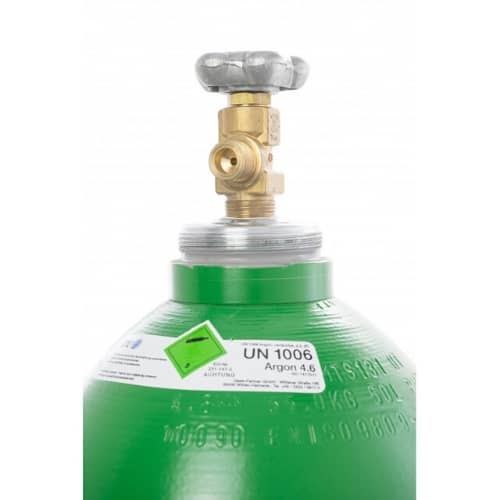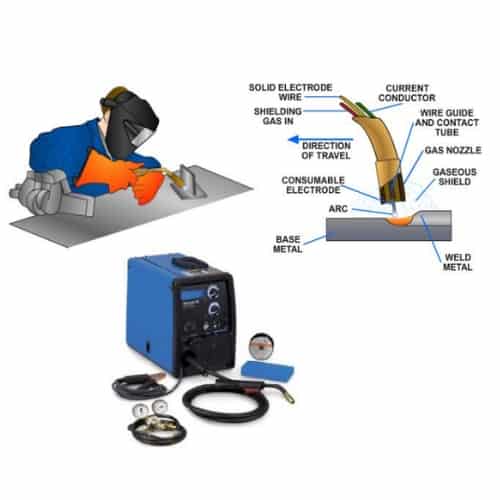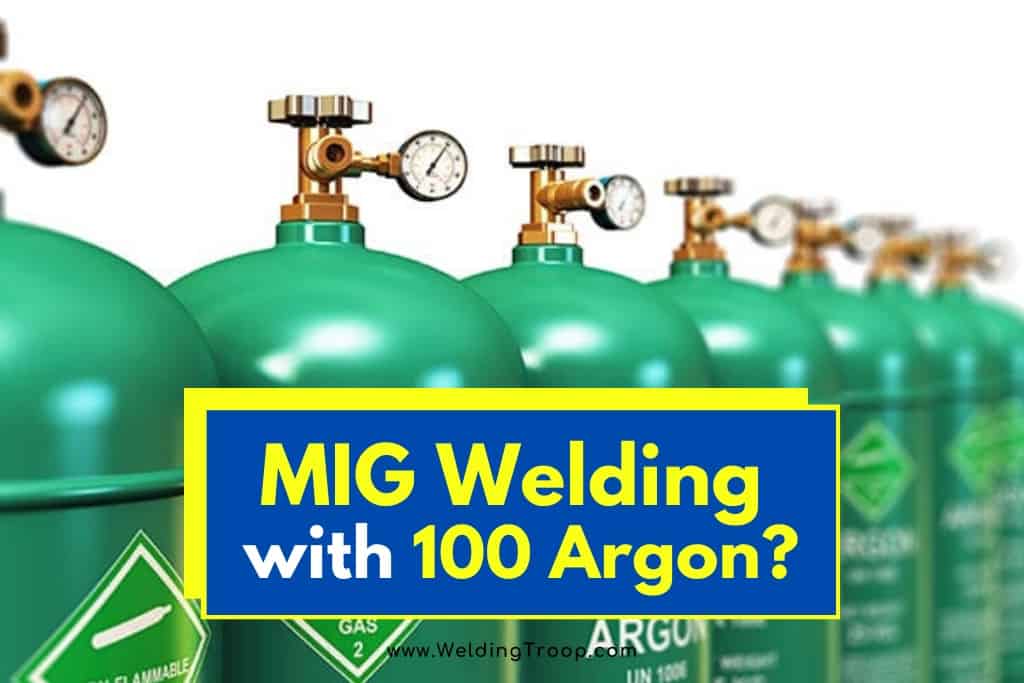MIG welding, or metal inert gas welding, is the preferred method of welding since its development during World War II. It was developed by factory workers to greatly increase production speed and maintain a uniform weld throughout the build.
MIG welding is much faster and cheaper than other forms of welding, but it is also one of the easiest forms of welding to learn. As some people say it is much like using a glue with a few extra steps.
Can you MIG weld mild steel with straight argon? Yes, you can use 100% Argon to MIG weld steel but this welding gas comes with many pros and cons. It is best to use a combination of the MIG welding gases in order to get the best results for your specific project.
Argon is one of the four gases used in MIG welding. When deciding if you should use argon gas for MIG welding, you should consider the specific qualities of your project such as thickness of metal, quality needed in the weld, and budget.
This article will discuss the pros and cons of MIG welding with argon along with answering the question that most people who are either just starting off in the welding industry or have never heard of the MIG welding process: what is MIG welding?
Table of Contents
MIG Welding With 100 Argon
Argon is widely used as an inert gas in MIG welding meaning it supplements another gas. Argon offers the welder to attain greater penetration, arc stability, and reduced splatter.
Argon is an inert gas which means that it does not react with other materials without a substantial amount of energy present.
The gas does not react with other materials or gases making it the perfect gas to use in the shielding process.
Related reading: What Gases Do MIG Welders Use >> Welding Shielding Gas | Complete Guide
100 Argon for MIG is capable of being used by itself, but only as a last resort because it leaves a very brittle and ugly welding bead that is narrow and not uniform.
The reason behind this is that 100% Argon does not have a high thermal conductivity so the outside of the gas flow is much cooler than that in the middle of the flow. This makes a small, narrow cavity in the metal that is prone to breaking and has a lot of splatter.

The use of the 100 Argon for MIG is acceptable to finish up a project if you run out of gas, or as a last resort, but, in the long term, the use of pure Argon for the MIG welding process is not recommended as it leads to a more brittle and less attractive weld.
MIG Welding with 100 Argon >> Check out the video below
MIG Welding
MIG welding is widely regarded as one of the simplest forms of welding that is widely used in the welding industry today. It has gained its popularity from its simplicity, cost effectiveness, speed, and ability to be easily customized to fit the specifics of the project you are working on.
As for what MIG welding is, that being how does the process of MIG welding work:
“MIG welding is an arc welding process in which a continuous solid wire electrode is fed through a welding gun and into the weld pool, joining the two base materials together.
Shielding gas is also sent through the welding gun and protects the weld pool from contamination.”
Source: Miller Electric Mfg. LLC
Related reading: 9 Different Types of Welding Processes & Their Advantages
The difference from other forms of welding that MIG welding has that it gives a huge advantage in that it continually feeds the wire through the nozzle to allow for continuous welding without having to replace the wire.
You can think of it like a hot glue gun in that you have only a certain amount of glue in the gun at any point in time.
If you replace the stick of glue with a twenty-foot long stick of glue, you would be able to use that glue gun for a longer period of time.
Where MIG welding falls short of other forms of welding is that it struggles to make good welds when the steel is rusty or not perfectly clean.
If you want the speed, quality, and efficiency that comes with the process of MIG welding, you have to ensure that the metal you plan to weld is clean.
The best way of doing this is by using a grinder or metal brush to get rid of all the contaminants that are on the metal before welding.
Related reading: How Much do MIG Welders Make? Average MIG Welder Salary
MIG Welding Gases
The process of MIG welding relies on the use of shielding gases to ensure that the welding pool does not come into contact with the gases in the atmosphere.
The shielding gases also direct the arc and wire to one location which minimizes splatter. When choosing what gas or gas combination to use in your MIG welding project you have to consider:
- Cost of the gas
- Finished weld properties
- Preparation
- After-weld clean up
- Base material
- Weld transfer process
- Productivity
You have full control of all these aspects of the welding process when using MIG welding.

The four gases used for MIG welding are:
- Argon
- Helium
- Carbon Dioxide
- Oxygen
With each of these gases having specific qualities that offer many benefits as well as drawbacks when using them for the MIG welding process. Most commonly, a combination of two of these gases is used in the process.
Related reading: How to Use a MIG Welder Without Gas | Is Gasless MIG Welding any Good?
Carbon Dioxide
Carbon Dioxide is the most common of these gases that is used in MIG welding. It is also the only one that can be used, effectively and is commonly used in its pure form.
Carbon Dioxide is also the least expensive of these gases which makes it more attractive to use over the other gases.
Pure Carbon Dioxide provides a deep welding penetration, which is perfect for thicker metals, but it has more spatter and a less stable arc when it is not mixed with other gases.
For those who put an emphasis on welding quality, a combination of Carbon Dioxide and Argon should be used for best results. Most consider a mixture of 75 to 95 percent Argon with the rest being pure Carbon Dioxide.
This combination provides a unique combination of arc stability, puddle control, and a reduced spatter than if you were just using Carbon Dioxide alone.
You are also able to perform a spray transfer which will lead to higher production rates and a higher quality weld.
Argon
Argon produces a narrower penetration cavity, which is perfect for fillet and butt welds. Also, if you need to weld a non-ferrous metal, metals containing iron such as; aluminum, magnesium, or titanium, Argon for MIG welding is needed to make the weld stick.
Oxygen
Oxygen is a super reactive gas; thus, it is used in lesser concentrations, usually below nine percent. Oxygen is used to improve weld pool fluidity, penetration and arc stability in low alloy steels.
Oxygen, however, directly causes oxidation in metals which weakens the overall stability of the metal, which means it cannot be used with metals prone to oxidation.
Related reading: Is Welding Oxygen the Same as Medical Oxygen?
Helium
Helium, like Argon, is used for non-ferrous metals, but can also be used for stainless steels. Helium also provides a wide, deep penetration cavity which means it is perfect for thicker metals.
Helium is typically used in ratios of 25 to 75 percent Helium to 75 to 25 percent Argon. When you adjust these ratios, you will change the aspects of weld like the penetration, bead profile, and travel speed.
Helium can also be used in a mixture of Argon and Carbon Dioxide to create a tri-blend of gases for maximum efficiency.
Related reading: Different types of gas welding flames and their applications | Ultimate Guide
If you are interested in welding gear or tools, then just follow the link to our recommendation page where you can see all welding accessories we love and use (NO CRAP)
+ Highest Quality
+ Tested & Approved
+ Affordable Machine
+ Right Balance Between Quality & Price


